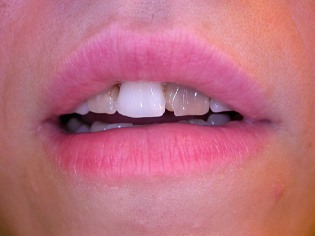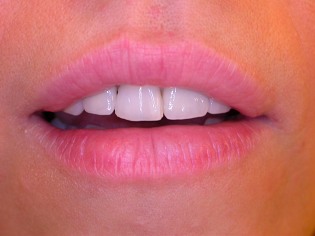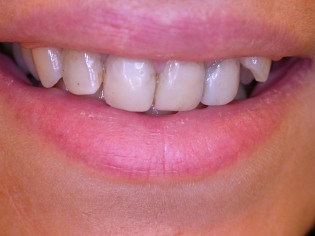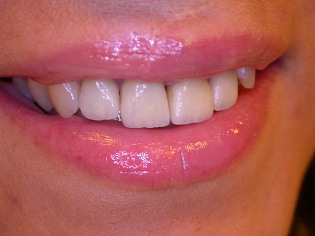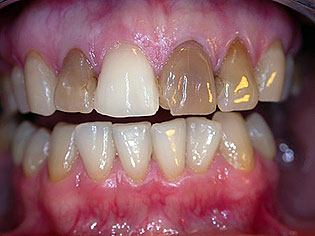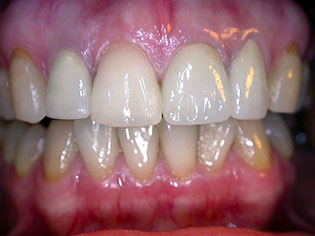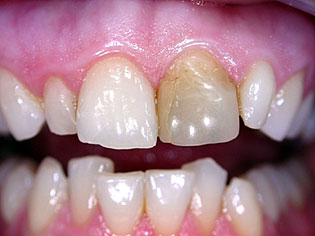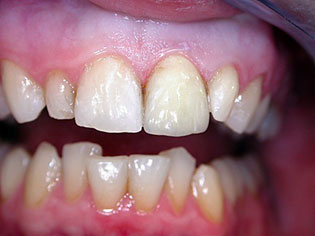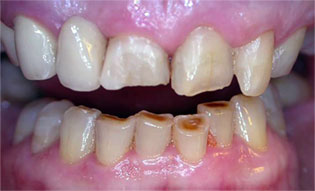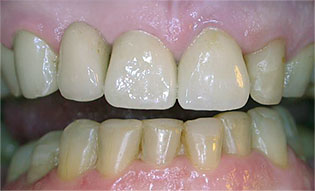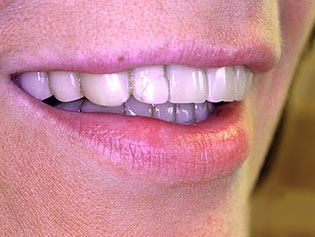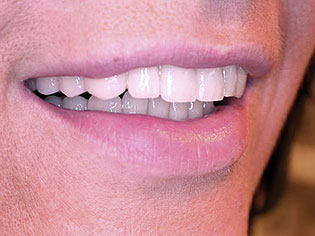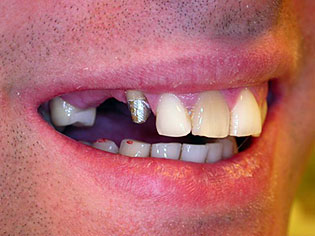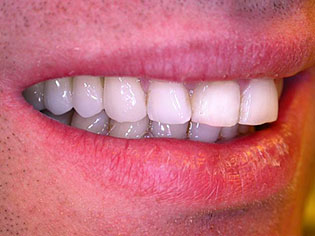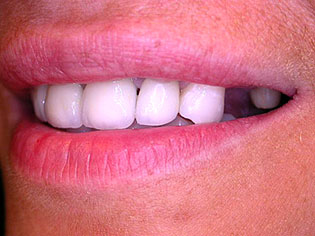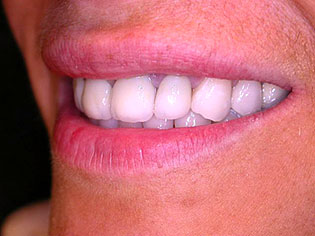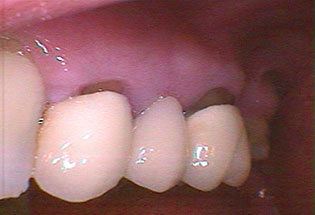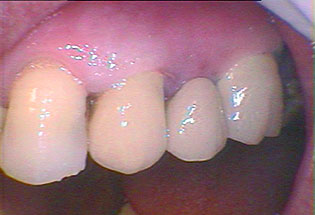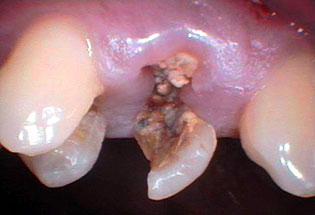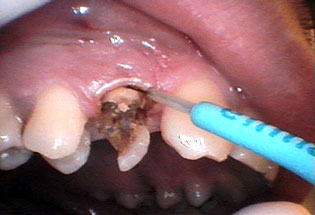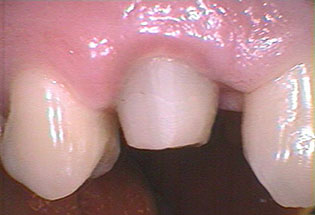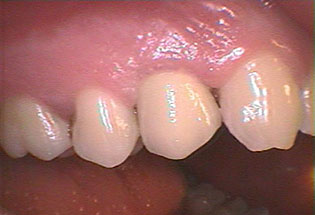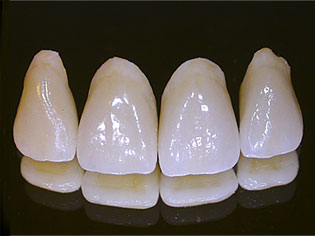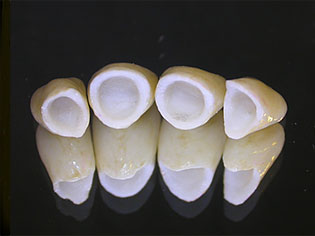TriDent Budapest, Hungary TREATMENTS AND CASE STUDIES
Treatments - case studies
Crowns and Bridges - case studies
Crowns
Crowns are synthetic caps, usually made of a material like porcelain (ceramic), precious metal (gold) and non precious metal alloys or combinations (PFM: Porcelain Fused to Metal, PFG: Porcelain Fused to Gold), placed on the top of a tooth.
Crowns are typically used to restore a tooth's function and appearance following a restorative procedure such as a root canal treatment. When decay in a tooth has become so advanced that large portions of the tooth must be removed, crowns are often used to restore the tooth.
Crowns are also used to attach bridges, cover implants, prevent a cracked tooth from becoming worse, or an existing filling is in jeopardy of becoming loose or dislocated. Crowns also serve an aesthetic use, and are applied when a discolored or stained tooth needs to be restored to its natural appearance.
Please see „Before and After” images below!
All the dental photographs, images and graphics are original materials performed and photographed by Dr. George Toth © TriDent Budapest.
Zirconia Crowns

Bridges
Bridges are natural-looking dental appliances that can replace a section of missing teeth. Because they are custom-made, bridges are barely noticeable and can restore the natural contour of teeth as well as the proper bite relationship between upper and lower teeth.
Porcelain, precious metal (gold) and non precious metal alloys or combinations (PFM: Porcelain Fused to Metal, PFG: Porcelain Fused to Gold) of materials are usually used to make bridge appliances.
Appliances called implant bridges are attached to an area below the gum tissue, or the bone.
Core build up
FAQ –Crowns and Bridges
- Procedures
- Why is a Dental Crown Needed?
- What Types of Crown Materials are Available?
- What Steps are Involved in Preparing a Tooth for a Crown?
- How Should I Care for My Temporary Dental Crown?
- How Long Do Dental Crowns Last?
- What Problems Could Develop With a Dental Crown?
- Does a Crowned Tooth Require any Special Care?
Procedures
A tooth must usually be reduced in size to accommodate a crown. An impression is taken of the existing tooth and an impression is made. The impression is sent to the dental technician’s lab, which manufactures a custom-designed crown. In some cases, a temporary crown is applied until the permanent crown is ready. Permanent crowns are cemented in place.
Crowns are sometimes confused with veneers, but they are quite different. Veneers are typically applied only to relatively small front areas.
Caring For Your Crowns
With proper care, a good quality crown could last up to eight years or longer. It is very important to floss in the area of the crown to avoid excess plaque or collection of debris around the restoration.
Certain behaviors such as jaw clenching or bruxism (teeth grinding) significantly shorten the life of a crown. Moreover, eating brittle foods, ice or hard candy can compromise the adhesion of the crown, or even damage the crown.
A dental crown may be needed when at least one of the following occurs:
1. To protect a weak tooth (for instance, from decay) from breaking or to hold together parts of a cracked tooth
2. To restore an already broken tooth or a tooth that has been severely worn down
3. To cover and support a tooth with a large filling when there isn't a lot of tooth left
4. To hold a dental bridge in place
5. To cover misshaped or severely discolored teeth
6. To cover a dental implant
A dental crown may be needed when at least one of the following occurs:
7. To protect a weak tooth (for instance, from decay) from breaking or to hold together parts of a cracked tooth
8. To restore an already broken tooth or a tooth that has been severely worn down
9. To cover and support a tooth with a large filling when there isn't a lot of tooth left
10. To hold a dental bridge in place
11. To cover misshaped or severely discolored teeth
12. To cover a dental implant
A dental crown may be needed when at least one of the following occurs:
13. To protect a weak tooth (for instance, from decay) from breaking or to hold together parts of a cracked tooth
14. To restore an already broken tooth or a tooth that has been severely worn down
15. To cover and support a tooth with a large filling when there isn't a lot of tooth left
16. To hold a dental bridge in place
17. To cover misshaped or severely discolored teeth
18. To cover a dental implant
Permanent crowns can be either all metal, porcelain-fused-to-metal, all resin, or all ceramic.
1. Metals used in crowns include gold alloy, other alloys (for example, palladium) or a base-metal alloy (for example, nickel or chromium). Compared with other crown types, less tooth structure needs to be removed with metal crowns, and tooth wear to opposing teeth is kept to a minimum. Metal crowns withstand biting and chewing forces well and probably last the longest in terms of wear down. Also, they rarely chip or break. The metallic color is the main drawback. Metal crowns are a good choice for out-of-sight molars.
2. Porcelain-fused-to-metal dental crowns can be color matched to your adjacent teeth (unlike the metallic crowns). However, more wearing to the opposing teeth occurs with this crown type compared with metal or resin crowns. The crown's porcelain portion can also chip or break off. Next to all-ceramic crowns, porcelain-fused-to-metal crowns look most like normal teeth. However, sometimes the metal underlying the crown's porcelain can show through as a dark line, especially at the gum line and even more so if your gums recede. These crowns can be a good choice for front or back teeth.
3. All-porcelain dental crowns provide the best natural color match than any other crown type and may be more suitable for people with metal allergies. However, they are not as strong as porcelain-fused-to-metal crowns. All-ceramic crowns are a good choice for front teeth.
Preparing a tooth for a crown usually requires three visits - the first step involves examining and preparing the tooth, the second visit involves the base try-in, the third visit involves the placement of the permanent crown.
1. Examining and preparing the tooth. At the first visit, our dentist may take a few x-rays to check the roots of the tooth receiving the crown and surrounding bone. If the tooth has extensive decay or if there is a risk of infection or injury to the tooth's pulp, a root canal treatment may first be performed.
Before the process of making your crown is begun, our dentist will anesthetize your tooth and the gum tissue around the tooth. Next, the tooth receiving the crown is filed down along the chewing surface and sides to make enough room for the crown. (If, on the other hand, a large area of the tooth is missing our dentist will use filling material to "build up" the tooth enough to support the crown.
After reshaping the tooth, our dentist will use impression material to make an impression of the tooth to receive the crown. The impressions are sent to our dental laboratory where the crown will be manufactured. The crown is usually returned to our dental surgery in less than 5 days. If your crown is made of porcelain, our dentist, the dental technician and you will choose the shade that most closely matches the color of the neighbouring teeth.
2. The base try-in. When a PFM (Porcelain Fused to Metal) or PFG (Porcelain Fused to Gold) crown is made, the metal base has to be tried in, in order to see the crown/bridge perfect fit to the core.
3. Receiving the permanent dental crown. At your third visit, our dentist will check the fit and color of the permanent crown. If everything is acceptable, a local anesthetic will be used to numb the tooth and the new crown is permanently cemented in place.
Metal free porcelain crowns before cementation
Because temporary dental crowns are just that – a temporary fix until a permanent crown is ready, most dentists suggest that a few precautions be taken with your temporary crown. These include:
1. Avoid sticky, chewy foods (for example, chewing gum, caramel), which have the potential of grabbing and pulling off the crown.
2. Minimize use of the side of your mouth with the temporary crown. Shift the bulk of your chewing to the other side of your mouth.
3. Avoid chewing hard foods (such as raw vegetables), which could dislodge or break the crown.
4. Slide dental floss out -rather than lifting out- when cleaning your teeth. Lifting the floss out, as you normally would, might pull off the temporary crown.
On average, dental crowns last between 5 and 15 years. The life span of a crown depends on the amount of "wear and tear" the crown is exposed to, how well you follow good oral hygiene practices, and your personal mouth-related habits (you should avoid such habits as grinding or clenching your teeth, chewing ice, biting your fingernails and using your teeth to open packaging).
1. Discomfort or sensitivity. Your newly crowned tooth may be sensitive immediately after the procedure as the anesthesia begins to wear off. If the tooth that has been crowned still has a nerve in it, you may experience some hot and cold sensitivity. Your dentist may recommend that you brush your teeth with a toothpaste designed for sensitive teeth. Pain or sensitivity that occurs when you bite down usually means that the crown is too high on the tooth. If this is the case, call our dentist. He or she can easily fix this problem.
2. Chipped crown. Crowns made of all porcelain can sometimes chip. If the chip is small, a composite resin can be used to repair the chip with the crown remaining in your mouth. If the chipping is extensive, the crown may need to be replaced.
3. Loose crown. Sometimes the cement washes out from under the crown. Not only this allows the crown to become loose, it allows bacteria to leak in and cause decay to the tooth that remains. If your crown feels loose, contact us.
4. Crown that falls off. Sometimes crowns fall off. Usually this is due to an improper fit or a lack of cement. If this happens, clean the crown and the front of your tooth. You can replace the crown temporarily using dental adhesive for dentures that is sold in pharmacies/drugstores for this purpose. Contact us immediately. Our dentist will give you specific instructions on how to care for your tooth and crown for the day or so until you can be seen for an evaluation. Our dentist may be able to re-cement your crown in place; if not, a new crown will need to be made.
5. Allergic reaction. Because the metals used to make crowns are usually a mixture of metals, an allergic reaction to the metals or porcelain used in crowns is extremely rare.
6. Dark line on crowned tooth next to the gum line. A dark line next to the gum line of your crowned tooth is normal, particularly if you have a porcelain-fused-to-metal crown. This dark line is simply the metal of the crown showing through. We can avoid this effect when preparing the tooth making a shoulder preparation, and a cosmetic crown with a ceramic shoulder at the visible parts of the gum line.
While a crowned tooth does not require any special care, remember that simply because a tooth is crowned does not mean the underlying tooth is protected from decay or gum disease. Therefore, continue to follow good oral hygiene practices, including brushing your teeth at least twice a day and flossing once a day-especially around the crown area where the gum meets the tooth.

